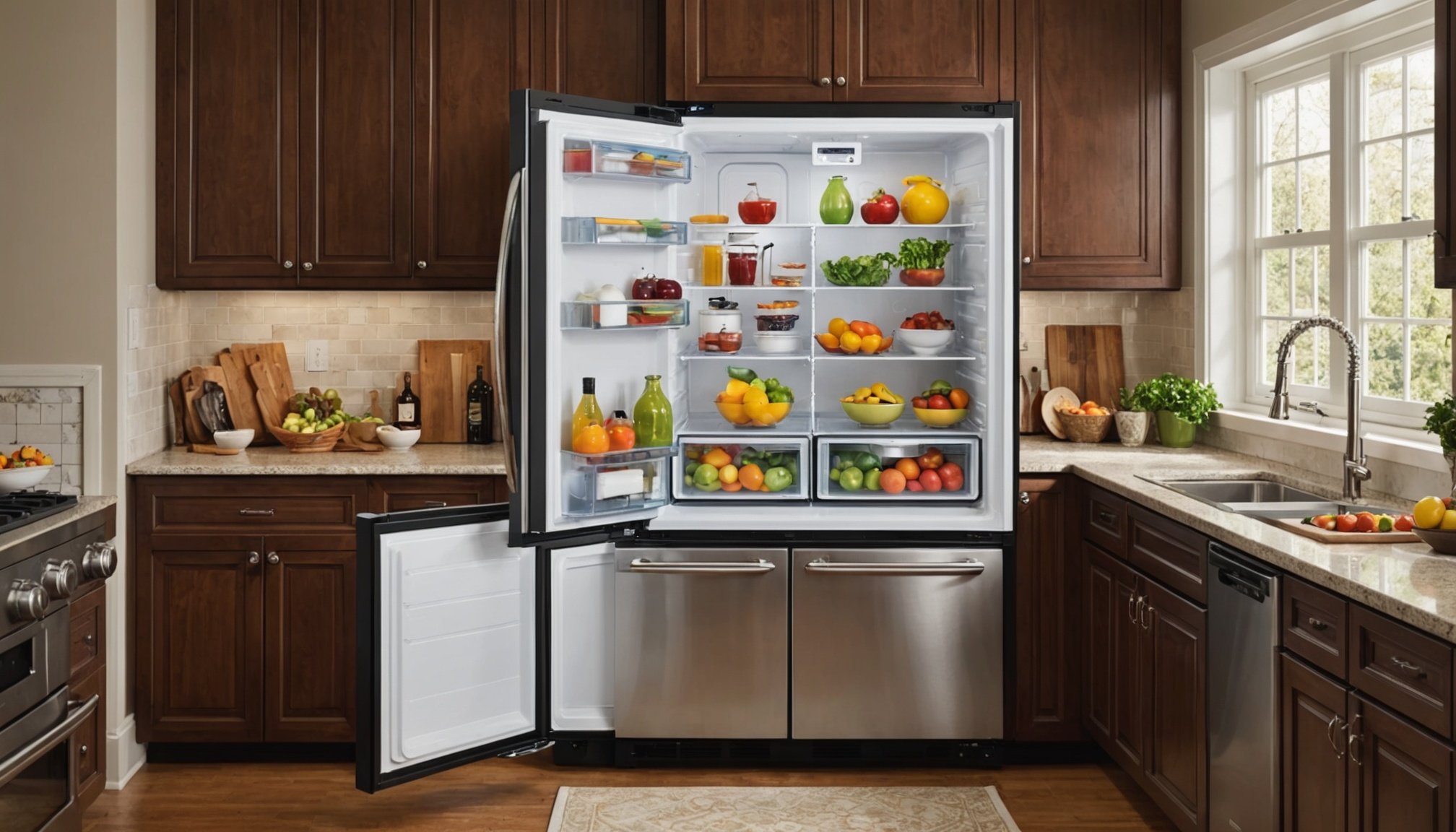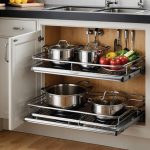Size and Capacity Considerations
Selecting the right refrigerator size depends greatly on a household’s needs. Families should first consider how much space they need for groceries, which involves understanding the refrigerator’s capacity for large families. A unit’s cubic footage is key; it directly influences how much the appliance can store.
When evaluating cubic footage, one must also think about the refrigerator’s configuration. Each style—be that side-by-side, French door, or top-freezer—offers distinct merits. Side-by-side refrigerators provide easy access to both frozen and fresh items. French door models are popular for their spaciousness and style, ideal for accommodating large families.
Have you seen this : Mastering sous vide: unlock the ideal temperature for succulent, moist chicken every time!
It’s essential to decide on a configuration that maximizes storage space and usability. For instance, French doors are praiseworthy for extensive storage needs and wide shelving. Conversely, side-by-side offers a narrow profile yet balances freezer and fridge accessibility. Closely consider which design best fits one’s kitchen layout and personal preferences, as storage organization plays a pivotal role in optimizing space.
Ultimately, a well-chosen refrigerator not only meets daily demands but also enhances kitchen efficiency. Ensuring ample cubic footage and preferred styling will make daily life smoother and more enjoyable for any family.
Have you seen this : Key factors to think about when selecting the ideal pasta maker for perfectly homemade noodles
Storage Options and Organization
Storage solutions in refrigerators can make a world of difference in maintaining order and utility. Many modern refrigerators offer a range of shelving styles and materials to cater to diverse needs. Adjustable shelves allow users to modify the fridge’s interior based on the size and shape of stored items.
Innovative features like pull-out drawers and door bins further enhance organization. Pull-out drawers offer easy access to items stored at the back, reducing the need to shuffle contents around. Door bins are perfect for storing smaller, frequently used items and can often be adjusted to fit larger bottles or cartons. This kind of flexibility is crucial, especially for households with varying grocery needs.
When selecting a refrigerator, consider the importance of such organization features to improve accessibility and reduce food wastage. Opting for a model with customizable options can lead to a more efficient use of space, ensuring that even larger families can manage their storage effectively. Being mindful of these elements can transform a cluttered fridge into a well-organized space, simplifying meal preparation and ensuring that food items remain easily accessible.
Energy Efficiency Ratings
Selecting an energy-efficient refrigerator can lead to cost savings and a reduced ecological footprint. Energy ratings, like the Energy Star certification, provide a useful gauge of an appliance’s performance—indicating lower power consumption and enhanced eco-friendliness. When assessing these ratings, consider the initial investment against potential long-term savings. Higher-rated models may have a steeper price tag but promise reduced energy bills over time.
Eco-friendly refrigerators often come equipped with features such as efficient insulation and advanced compressors, which help maintain optimal temperatures with minimal effort. These technologies contribute to both energy conservation and extended appliance life. It’s crucial to weigh these benefits when making purchasing decisions.
Furthermore, aiming for eco-conscious choices does not mean sacrificing performance. Many energy-efficient models boast features like adjustable thermostats and humidity controls that offer tailor-made climate management for diverse grocery needs.
Ultimately, understanding energy ratings goes beyond just numbers—it’s about selecting a refrigerator that provides excellent performance while being mindful of environmental impact. Striking this balance ensures a sound investment, benefiting both your household budget and our planet’s health.
Brand Recommendations
Choosing from the best refrigerator brands is essential for a reliable and satisfactory purchase. In 2023, consumer feedback highlights several top brands for their spacious models and innovative features. Samsung and LG are frequently praised for their smart technology integration, making them ideal for tech-savvy households aiming for convenience and efficiency. Their reputation for durability and sleek design options also contributes to high consumer satisfaction ratings.
Whirlpool and GE are celebrated for their consistent performance and robust build, known for being reliable refrigerator manufacturers. They cater exceptionally to larger families, providing models with considerable storage capacity and user-friendly features. These brands often include energy-efficient solutions, aligning well with eco-conscious consumers.
When assessing brands, pay attention to the specific features each offers, such as adjustable thermostats or customizable shelving, which enhance usability and flexibility. Consumer satisfaction also depends on post-purchase support, making it vital to consider the warranty and service offerings of each brand.
Ultimately, securing a refrigerator from a trustworthy brand ensures not only reliability but also enhanced kitchen efficiency, meeting diverse household demands while offering long-term savings and satisfaction.
Budget Considerations
When determining the right refrigerator, knowing about refrigerator pricing helps make informed decisions. Setting a realistic budget involves analysing one’s needs and the features desired. Budget-friendly options often meet basic needs, whereas premium models provide advanced features and enhanced efficiency, possibly justifying a higher price point.
It’s crucial to understand not just the immediate cost but also the importance of a warranty and potential long-term expenses related to maintenance and energy consumption. Entry-level models may offer robustness without frills, making them ideal for smaller families or those with minimal requirements. However, premium models often include smart technology integrations, customizable storage, and advanced energy efficiency—making them a thoughtful investment for tech-savvy households or larger families needing greater flexibility and storage space.
Comparing various models allows buyers to gauge which features hold the most value, aligning with their budget. Long-term savings can also be significant when opting for energy-efficient appliances, which may have higher initial costs but promise reduced utility bills over time. A careful comparison ensures that buyers select the most suitable refrigerator, balancing immediate costs and future savings.
Maintenance and Care Tips
Taking care of your refrigerator through regular maintenance not only extends its lifespan but also enhances performance. Routine cleaning and upkeep are vital. A simple clean involves wiping the interior and exterior with mild soap and water, ensuring no harsh chemicals are involved that might damage the surface. Vacuuming the coils on the back or bottom ensures better energy efficiency.
Inspecting seals is crucial for maintaining efficiency. If the door doesn’t close tightly, cold air escapes, leading to energy waste. You can test the seal’s effectiveness by closing the door on a piece of paper—if it slides out easily, consider cleaning the gasket or replacing it if needed.
Be proactive with troubleshooting common issues. Noise, uneven cooling, or frost build-up may signal problems like blocked vents or faulty thermostats. Regularly checking these can prevent larger issues from arising.
For large appliances, avoiding overloading and ensuring proper ventilation space around the fridge can significantly improve efficiency. This conscientious care not only guarantees optimal performance but also reflects cost savings over time, aligning well with eco-conscious households seeking sustainable use.
Model Comparisons and User Reviews
Refrigerator comparisons play a critical role in choosing the right model for your home. Comparing top-rated models side-by-side reveals variations in features, capacity, and price, aiding informed decisions. When evaluating, key elements like energy efficiency, storage options, and design are vital. For instance, some models offer superior organization in refrigerators, featuring adjustable shelves and pull-out drawers that accommodate varied grocery needs.
User feedback adds valuable insights, often highlighting practical experiences that specifications alone cannot capture. Reviews frequently mention convenience-enhancing aspects such as ease of cleaning and maintenance, reflecting user satisfaction. Common feedback indicates that models excelling in energy efficiency, like those with an Energy Star rating, are highly favored for offering long-term savings even with a potentially higher upfront cost.
Highlighting the pros and cons of different models helps prospective buyers weigh their choices. Many consumers appreciate reliable brands that combine spacious interiors with smart technology, enhancing convenience. On the downside, some users find certain models noisy or challenging to configure within confined spaces. Analyzing these elements supports purchasing decisions tailored to individual preferences and household requirements.











